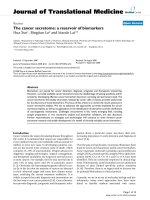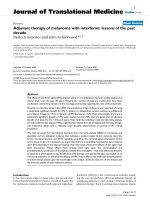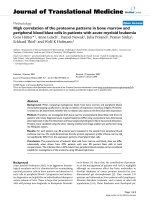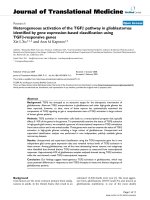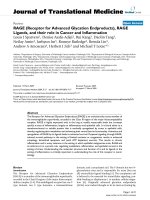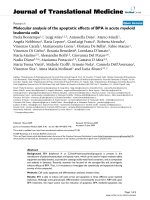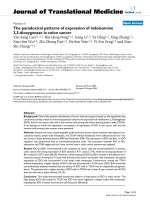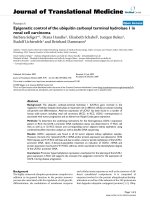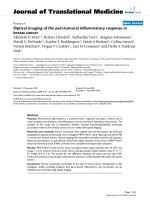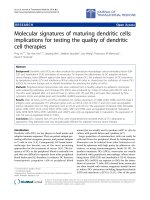báo cáo hóa học:" The influence of the level of physical activity and human development in the quality of life in survivors of stroke" potx
Bạn đang xem bản rút gọn của tài liệu. Xem và tải ngay bản đầy đủ của tài liệu tại đây (242.85 KB, 6 trang )
RESEARCH Open Access
The influence of the level of physical activity and
human development in the quality of life in
survivors of stroke
Felipe J Aidar
1*
, Ricardo J de Oliveira
2
, António J Silva
1
, Dihogo G de Matos
1
, André L Carneiro
1
, Nuno Garrido
1
,
Robert C Hickner
3
and Victor M Reis
1
Abstract
Background: The association between physical activity and quality of life in stroke survivors has not been analyzed
within a framework related to the human development index. This study aimed to identify differences in physical
activity level and in the quality of life of stroke survivors in two cities differing in economic aspects of the human
development index.
Methods: Two groups of subjects who had suffered a stroke at least a year prior to testing and showed
hemiplegia or hemiparesis were studied: a group from Belo Horizonte (BH) with 48 people (51.5 ± 8.7 years) and
one from Montes Claros (MC) with 29 subjects (55.4 ± 8.1 years). Subsequently, regardless of location, the groups
were divided into Active and Insufficiently Active so their difference in terms of quality of life could be analyzed.
Results: There were no significant differences between BH and MCG when it came to four dimensions of physical
health that were evaluated (physical functioning, physical aspect, pain and health status) or in the following four
dimensions of mental health status (vitality, social aspect, emotional aspect and mental health). However,
significantly higher mean values were found in Active when compared with Insufficiently Active individuals in
various measures of physical health (physical functioning 56.2 ± 4.4 vs. 47.4 ± 6.9; physical aspect 66.5 ± 6.5 vs.
59.1 ± 6.7; pain 55.9 ± 6.2 vs. 47.7 ± 6.0; health status 67.2 ± 4.2 vs. 56.6 ± 7.8) (arbitrary units), and mental health
(vitality 60.9 ± 6.8 vs. 54.1 ± 7.2; social aspect 60.4 ± 7.1 vs. 54.2 ± 7.4; emotional aspect 64.0 ± 5.5 vs. 58.1 ± 6.9;
mental health status 66.2 ± 5.5 vs. 58.4 ± 7.5) (arbitrary units).
Conclusions: Despite the difference between the cities concerning HDI values, no significant differences in quality
of life were found between BH and MCG. However, the Active group showed significantly better results,
confirming the importance of active lifestyle to enhance quality of life in stroke survivors.
Keywords: Cerebrovascular Accident, Physical Activity, Stroke, Quality of Life
Background
Indicators related to health have assumed a prominent
position in the measurement of human development.
The incidence of disease in many countries has signifi-
cantly increased in recent years [1-4]. Stroke currently
occupies the third position with regard to mortality,
being also the leading cause of disability in Western
countries and ranking first in terms of loss of quality
adjusted life years [1-3]. Moreover, problems related to
hemiplegia, hemiparesis and aphasia occur frequently in
stroke victims, and cause direct and indirect financial
impacts on the public health system [4,5]. In Brazil, the
dise ase account s for one third of the deaths from circu-
latory diseases per year, and has a prominent place next
to cardiovascular diseases [6].
There is epidemiological evidence that physical activity
may lower mortality due to cardiovascular events, which
could be explained by a lower blood pressure, an
increased HDL-C and a lower incidence of diabetes in
physical active people [7]. Additionally, studies have
* Correspondence:
1
Department of Sports Science, Exercise and Health of the Trás-os-Montes e
Alto Douro University, Vila Real, Portugal
Full list of author information is available at the end of the article
Aidar et al. Health and Quality of Life Outcomes 2011, 9:89
/>© 2011 Aidar et al; licensee BioMed Central Ltd. This is an Open Access article distributed under the terms of the Creative Commons
Attribution License ( whi ch permits u nrestrict ed use, distribution, and reproduction in
any medium, provided the original work is properly cited.
shown that physical activity attenuates the re-incidence
of strokes and improves the quality of life (QOL) post-
stroke [8,9].
Despite the proven positive impact of physical activity
on QOL, analysis of this relationship within a frame-
work related to the Human Development Index (HDI) is
absent in the literature. There has always been a world-
wide concern to measure the levels of human develop-
ment. Thus, in early 1990, the H DI was created by the
United Nations (UN). The HDI is a multifaceted index
of human development that is based on economic indi-
cators as well as indicators related to education and
longevity. The HDI is the best known human develop-
ment index [1].
Thus, this study aimed to identify differences in physi-
cal activity level and in the quality of life of stroke survi-
vors in two cities differing in human development index
ranking in Brazil.
Methods
Sample
The study included, initially, 77 people: 48 from the
Metropolitan Region of Belo Horizonte (BH: Brazil HDI
ranking of 80), Minas Gerais, Brazil (BHG) and 29 from
Montes Claros (MC: Brazil HDI ranking of 968), Minas
Gerais, Brazil (MCG) (Table 1). Later the subjects were
divided into two groups (Active, and Insufficiently
Active) based on the amount of physical activity per-
formed (Table 2), regardless of the place of residence.
The groups were composed of people who voluntarily
sought a physical activity p rogram offered by the Fire-
fighters of Minas Gerais. The program assists people
with special needs and organizes physical activities.
The eligibility criteria consisted of the individual hav-
ing suffered a stroke at least one year prior to the study
and showing sequelae, hemiplegia or hemiparesis.
The individuals were classified according to the Ran-
kin Scale [10,11], and in the BHG 33.1% had mild dis-
ability, 44.2% showed moderate disability and 22.7%
higher disability. In the MCG 26.4% had mild disability,
48.5% showed moderate disability and 22.1% higher dis-
ability. In a second classification using the same scale,
for the Active group, 29.7% individuals had mild disabil-
ity, 50.8% showed moderate disability and 19.5% higher
disability. For the Insufficiently Active group 24.4% had
mild disability, 47.8% moderate disability and 27.8%
higher disability.
All volunteers were informed about the study and
signed a consent document in accordance with the
Declaration of Helsinki (1964, revised in 1975, 1983,
1989, 1996 and 2000). The p rocedures were approved
by the institution ethics committee.
Procedures
Data collection was performed at the time of registra-
tion for the program, and all interview s were conducted
by a single experienced social services technician. The
interviews evaluated the HDI, the QOL SF36 and the
IPAQ, as described below.
Instruments
Human Development Index-HDI
The HDI seeks to demonstrate the success achieved in
three basic human needs: access to knowledge (educa-
tion), the right to a long and healthy life (longevity) and
the right to a decent standard of living (income).
Regarding education (HDI-E), the indicators are the
literacy rate of the population over 15 years and the
proportion of people with access to primary, secondary
and higher education. When it comes to longevity
(HDI-L), the indicator is represented by life expectan cy,
whereas the indicator for income (HDI-I ) is represented
by the GDP per capita, which synthesizes the popula-
tion’ s capacity to purchase goods and services, thus
tending to re present the access to other dimensions not
covered by the HDI.
The process of HDI determination consists of choos-
ing upper and lower parameters for each indicator and
the normalization is given by an equation that measures
the distance between the observed value for the indica-
tor and the minimum value a s a proportion of the
Table 1 Age of participants in groups sorted by HDI of
the cities
Belo Horizonte Group Ocurrence/Means ± SD
Age (yr) 51.5 ± 8.7
Age-male (yr) 50.7 ± 7.8
Age-female (yr) 52.3 ± 6.8
Gender (Men/Women) (%) 18 (37.5)/30 (62.5)
Montes Claros Group Ocurrence/Means ± SD
Age (yr) 55.4 ± 8.1
Age-male (yr) 53.2 ± 9.6
Age-female (yr) 57.6 ± 7.7
Gender (Men/Women) (%) 11 (37.9)/18 (82.1)
Table 2 Age of participants in groups sorted by level of
physical activity
Active Ocurrence/Means ± SD
Age (yr) 56.1 ± 6.1
Age-male (yr) 54.8 ± 8.3
Age-female (yr) 57.4 ± 5.7
Gender (Men/women) (%) 6 (28.6)/15 (71.4)
Insufficiently Active Ocurrence/Means ± SD
Age (yr) 50.8 ± 8.1
Age-male (yr) 50.1 ± 6.8
Age-female (yr) 51.5 ± 5.9
Gender (Men/women) (%) 20 (35.7)/36 (64.3)
Aidar et al. Health and Quality of Life Outcomes 2011, 9:89
/>Page 2 of 6
distance between the maximum and minimum value
where I = (observed value-minimum value)/(maximum
value-minimum value). Thus, the closer the observed
value is to the minimum value, the smaller is the
numerator and therefore the worse the situation o f
development. Conversely, the closer the observed value
is to the maximum value, the better the situation in
terms of development.
The maximum and minimum values are defined
through the observation of t he world tendencies in
terms of i ndicators for the long term, allowing periodic
comparisons of the indexes obtained.
It is noteworthy that there are 27 states in Brazil, and
that the HDI Table is based on the territorial division in
2000, year of completion of the last census, with 5,507
cities. The periods of interest for this study, on the
other hand, correspond to the years until 2010, when
the number of municipalities in the National Territory
was already 5,564. Therefore, the absence of HDI was
verified for 57 new municipalities. However, Minas Ger-
ais (the state targeted by the present study) continued in
the period with 853 municipalities; thereby showing no
change in its geopolitical scenario (see table 3).
In this sense, both the HDI and its three sub-indices
(HDI-E, HDI-L and HDI-I) vary (arbitrary units)
between 0 and 1, being classified as 0 to 0.5 low human
development, from 0.5 to 0.8 medium human develop-
ment and 0.8 to 1, high human development [12].
Generic Questionnaire for the Assessment of Quality of Life
SF 36, Health Research
The “ Generic Questionnaire for the Assessment of
Quality of Life"-SF 36 “ Health Research”,previously
validated [13-16], consists of 36 questions, ten of
which related to functional capacity, four to physical
aspects, two related to pain, five to health status, four
to vitality, two associated with social aspects, three
with emotional aspects, five with mental health, and
one related to current health condition and one year
after stroke [17].
The questionnaire is based on a review of existing
instruments, taking into account functional changes and
limitations, as well as social aspects [14]. The scores
range from zero to 100 (arbitrary units), with higher
scores indicating better quality of life.
“International Physical Activity Questionnaire"-IPAQ
In order to verify the level of physical activities per-
formed, the International Physical Activity Question-
naire-IPAQ was used in its short version, containing
objective questions regarding the frequency and dura-
tion of the physical activities. Individuals were classified
as very active, active, irregularly active and sedentary
[18].
IPAQ Classification
The IPAQ contained questions about activities per-
formed during the week prior to the questionnaire. The
subjects’ data were tabulated, evaluated and ranked
according to the IPAQ, which divides and conceptua-
lizes categories as follows:
- Sedentary: Not performing any physical activity for
at least 10 continuous minutes during the week;
- Insufficiently activ e: individuals who practice physi-
cal activities for at least 10 continuous minutes per
week, but insufficiently to be classified as active. For the
classification of the individuals under this category , the
length and frequency of the different types of activities
(hiking + moderate + vigorous) were taken into account.
This category is divided into two groups:
-InsufficientlyActiveA:Performing 10 minutes of
continuous physical activity, following at least one of the
above criteria: f requency 5 days/week or duration-1 50
minutes/week;
- Insufficiently Active B: Not meeting any of the cri-
teria adopted for Insufficiently Active A;
-Active:Meets the following recommendations: a)
vigorous physical activity-> 3 days/week and > 20 min-
utes/session; b) moderate or walking-> 5 days/week and
> 30 minutes/session; c) any activity added > 5 days/
week and > 150 min/week;
- Very Active: Meets the following recommendations:
a) vigorous-> 5 days/week and > 30 min/session; b) vig-
orous-> 3 days/week and > 20 minutes/session + mod-
erate or walking 3-5 days/week and > 30 minutes/
session.
For the study, very active and activ e individuals were
classified as Active, whereas insufficiently active and
sedentary subjects were placed in the Insufficiently
Active group.
Statistics
Statistical analysis was done with the groups (BHG
and MCG) and the homogeneity of the sample was
verified through th e Shapiro Wilk test. Given the non-
normality of the sample, the Mann-Whitney test was
used for checking the difference in quality of life in
different cities, as well as for checking the difference
in quality of life between active and insufficiently
active groups.
Table 3 HDI and development indicators in the cities of
reference
City LEB PCI HDIM-L HDI-E HDI-I HDI-M NR
Belo Horizonte 70.520 557.435 0.759 0.929 0.828 0.839 80
Montes Claros 72.247 245.425 0.787 0.872 0.691 0.784 968
Source: Minas Gerais. João Pinheiro Foundation. United Nations (UN) [19]*
Abbreviations:
HDIM-L: Municipal Human Development Index-Longevity; LEB: Life Expectancy
at Birth; PCI: Per Capita Income; HDI-E: Education Index; HDI-I: Gross Domestic
Income; HDI-M: Municipal Human Development Index; NR: National Ranking
*This publication contained only descriptive data of HDI.
Aidar et al. Health and Quality of Life Outcomes 2011, 9:89
/>Page 3 of 6
We adopted a p < 0.05, and the data analysis was car-
ried out using SPSS for Windows version 15.0.
Results
The values for HDI are described in Table 3. It is note-
worthy that both Belo Horizonte and Montes Claros are
in the state of Minas Gerais, which has the second best
performance in t he country in economic terms. How-
ever, Montes Claros has only a moderate HDI-I eco-
nomic indicator (0.691), a per capita income of 245,425,
and a national HDI ranking of 968; whereas Belo Hori-
zonte has a high HDI-I economic indicator (0.828), a
percapitaincomeof557,435,andanationalHDIrank-
ing of 80.
Patients coming from the cities of Belo Horizonte and
Montes Clar os were evaluated with respect to quality of
life (Table 4).
There were no statistically significant differences
between the quality of life in BH and MC, which are
cities with different HDI.
Subsequently, the level of quality of life in all partici-
pants was evaluated in relation to the amount of physi-
cal activity performed, according to the SF 36
questionnaire, regardless of location (Table 5).
Discussion
This study aimed to identify differe nces in physical
activity level and in the quality of life of stroke survivors
in two cities differing in economic aspects of the human
development index. The main findings of the present
study were that factors such as location and socioeco-
nomic issues cannot be considered, de per si,indicators
of quality of life, and that physical activity plays an
important role in i mprovi ng quality of life, regardless of
the HDI-I economic indicator or HDI national ranking
status of the city of residence.
When evaluating the indicators of HDI in the two
cities, significant differences were found with regard to
per capita income (245.425 R$ in MC and 557.435 R$
in BH), HDI-I, which represents the gross domestic pro-
duct (0.691 in MC and 0.828 in BH) and the position of
the municipalities in the Brazilian HDI ranking (968
th
place for MC and 80
th
place for BH). However, other
indicators showed no major differences, such as the
education-related HDI-E, which was 0.929 in BH and
0.872 in MC. It is noteworthy that Montes Claros,
although economically poorer, has a higher life expec-
tancy at b irth (LEB) than does Belo Horizonte (72.242
yrs in MC and 70.520 yrs in BH) [12]. Contrary to our
findings that the economic indicators o f HDI were not
decisive determinants of quality of life in survivors of
stroke, another study found that socioeconomic condi-
tions and difficulties in accessing health services tend to
expose people to an increased risk of death [20,21].
One possible explanation for stroke survivorship and
quality of life, regardless of economic indicators in HDI,
can be attributed to the fact that there is now a univer-
salized health system in Brazil. The Brazilian health car e
system now offers more standard treatments, more
accurate diagnoses, and acts within a time considered
optimal, i.e. within three hours after the stroke and with
the most appropriate procedure [22-29]. In recent years
there has been a downward trend in cerebrovascular
problems, which allowed Brazilian indices to be close to
those seen in countries like the U.S. and Canada. This is
a reflection of i mprovements in public health policies
pursued in recent years [28].
Diagnosis and treatment carried out in the early stages
of stroke tend to decreas e the length of stay in hospit al,
improve patient prospects and decrease chances of per-
manent sequelae. These f indings from our previous
study [28] leads us to believe that economic standing
seems not to be a determini ng factor in quality of life.
This explains the absence of significant differences in
quality of life in patients affected by stroke in Belo Hori-
zonte and Montes Claros, who were subjected to similar
Table 4 Measures of physical and mental health
according to the SF 36 Questionnaire in groups
BH MCG P
Physical Health
Functional capacity 49.1 ± 6.0 47.5 ± 7.9 0,706
Physical Aspects 61.3 ± 6.7 59.4 ± 7.7 0,804
Pain 48.2 ± 6.2 50.1 ± 6.0 0,077
General Health Status 58.8 ± 7.9 59.3 ± 6.8 0,913
Mental Health
Vitality 56.5 ± 7.6 55.2 ± 8.2 0,638
Social Aspects 55.2 ± 6.6 54.5 ± 8.4 0,103
Emotional Aspects 58.4 ± 5.4 59.3 ± 7.9 0,079
Mental Health 61.2 ± 4.5 59.1 ± 8.5 0,051
* p < 0,05 (Mann-Whitney). Data are presented as mean ± SD.
Table 5 Measures of physical and mental health in the
Active and the Insufficiently Active Group
Active Insufficiently Active P
Physical Health
Functional Capacity 56.2 ± 4.4* 47.4 ± 6.9 0,036
Physical Aspects 66.5 ± 6.5* 59.1 ± 6.7 0,042
Pain 55.9 ± 6.2* 47.7 ± 6.0 0,035
General Health Status 67.2 ± 4.2* 56.6 ± 7.8 0,003
Mental Health
Vitality 60.9 ± 6.8* 54.1 ± 7.2 0,038
Social Aspects 60.4 ± 7.1* 54.2 ± 7.4 0,036
Emotional Aspects 64.0 ± 5.5* 58.1 ± 6.9 0,022
Mental Health 66.2 ± 5.5* 58.4 ± 7.5 0,012
* p < 0,05 (Mann-Whitney). Data are presented as mean ± SD
Aidar et al. Health and Quality of Life Outcomes 2011, 9:89
/>Page 4 of 6
treatment despite the aforementioned economic d iffer-
ences (HDI-R BH = 0.828 and MC = 0.691). On the
otherhand,delayedtreatmentmaybemoredifficult
and leave sequelae, regardless of location [30].
Comparing our results with those of other studies,
research conducted in Chile with pat ients who had suf-
fered a stroke more than three years before showed bet-
ter results than those found in our study in terms of
quality of life. In that study, 59 patients (average age of
62 and 51% female) were evaluated. Nearly half (n = 29:
49.1%) of the patients had some limitation. Thirty
patients (50.9%) presented with functional indepen-
dence, despite showing minimal sequelae. The group of
stroke survivors (aged 20-36 years) achieved an average
of 84 points, and the older group (average age of 75
years) achieved an average quality of life score of 63
points [31].
It is believed that changes in lifestyle play a major role
in the prognosis of patient s who suffered stroke [32,33].
Likewise, a study conducted in Japan showed that physi-
cal activity tends to reduce the risk of mortality in
patients who had stroke [34]. Physical activity is also
believed to be beneficial i n cases of ischemic stroke,
reducing the area of ischemia in animals [35-37].
Although caution should be taken when extrapolating
results from animal studies to humans, it appears that
physical activity may lessen the severity of stroke,
improving quality of life and the capacity for work and
leisure, thereby reducing the chances of new strokes and
the functional imitations they can bring [34,36]. I n this
sense, physical activities can be considered the best way
to improve the psychosocial indicators, quality of life
and stress levels in people with physical limitations,
bringing about improvements in social and emotional
health [9].
Additionally, physical exercises are a major method of
reducing stress and improving social and emotional
well-being in people with physical limitations [9]. Speci-
fically in relation to stroke survivors, daily physical activ-
ity can improve quality of life as confirmed in a previous
study of 40 stroke survivors. We assessed participation
in daily physical activity post stroke in relation to quality
of life and health. The results suggest that daily physical
activity on an outpatient basis is associated with a better
quality of life and health in stroke survivors [38]. Similar
results were obtained in a study of stroke survivors sub-
jected to water activities [8]. Quality of life was better in
the physically active stroke survivors than those who
were not active [8].
Conclusion
We therefore conclude that factors such as location and
socioeconomic issues cannot be considered, de per si,
indicators of quality of life, and that physical activity
plays an important role in improving quality of life,
regardless of the HDI ranking and economic status of
the city of residence.
Author details
1
Department of Sports Science, Exercise and Health of the Trás-os-Montes e
Alto Douro University, Vila Real, Portugal.
2
University of Brasília-Unb, Brasília,
Distrito Federal, Brazil.
3
Human Performance Laboratory, Department of
Exercise and Sport Science, and Department of Physiology, East Carolina
University. Greenville, NC, USA.
Authors’ contributions
FJA and DGM conceived the study. NG, ALC, AJS participated in data
collections of the study, VR conducted data analysis. RJO and RCH
participated in interpretation of data and manuscript preparation. All of the
authors reviewed the manuscript prior to submission.
Competing interests
The authors declare that they have no competing interests.
Felipe José Aidar had no contracts or financial dealings with any company
related to this manuscript. Ricardo Jacó de Oliveira, António José Silva,
Dihogo Gama de Matos, Nuno Garrido, André Luiz Carneiro, Robert C.
Hickner and Victor Machado Reis have no consultant ships, company
holdings or patents. This study did not receive any financial support for
research. All authors any direct or indirect conflicts of interests related to this
manuscript. All authors meet the criteria for authorship stated in the
Uniform Requirements for Manuscripts Submitted to Health and Quality of
Life Outcomes.
Received: 9 February 2011 Accepted: 13 October 2011
Published: 13 October 2011
References
1. Torres HG, Ferreira MP, Dinni NP: Social indicators: why build new ones as
the IPRS. São Paulo perspective 2003, 17:80-90.
2. Frey JL, Jahnke HK, Bulfinch EW: Differences in Stroke Between White,
Hispanic, and Native American Patients The Barrow Neurological
Institute Stroke Database. Stroke 1998, 29:29-33.
3. Kjeldsen SE, Erdine S, Farsang C, Sleight P, Mancia G: 1999 WHO/ISH
Hypertension Guidelines subcommittee 1999 WHO/ISH Hypertension
Guidelines-highlights & ESH update. J Hypertens 2002, 20:153-5.
4. Menotti A, Jacobs DR Jr, Blackburn H, Kromhout D, Nissinen A,
Nedeljkovic S: Twenty-five-year prediction of stroke deaths in the seven
countries study: the role of blood pressure and its changes. Stroke 1996,
27:381-7.
5. Shahar E, McGovern PG, Pankow JS, Doliszny KM, Smith MA, Blackburn H:
Stroke rates during the 1980s. The Minnesota Stroke Survey. Stroke 1997,
28:275-9.
6. Pittella JEH, Duarte JE: Prevalence and pattern of distribution of
cerebrovascular disease in 242 elderly people, coming from a general
hospital, autopsied in Belo Horizonte, Minas Gerais, during 1976 to
1997. Arq Neuropsiquiatr 2002, 60:47-55.
7. Kokkinos P: Physical activity and cardiovascular disease prevention:
current recommendations. Angiology 2008, 59(Suppl 3):26S-9S.
8. Aidar FJ, Silva AJ, Reis VM, Carneiro A, Carneiro-Cotta S: Study of quality of
life in ischemic stroke and its relationship with physical activity. J Neurol
2007, 45:518-522.
9. Carod-Artad FJ: Post stroke depression (I). Epidemiology, diagnostic
criteria and risk factors. J Neurol 2006, 42:169-75.
10. Haan DR, Limburg M, Bossuyt P, Meulen JVD, A a ronson N: The clinical
meaning of rankin handicap grades after stroke. Stroke 1995,
26:2027-2030.
11. Brazilian Society of Cerebrovascular Diseases (BSCD): Working Group on
Cerebrovascular Pathology of ABN. Rankin scale of disability changed
and modified Barthel index. Newsletter 1999, 6:7-12.
12. United Nations Program for Development (UNPD): Human Development
Report 2009. Overcoming barriers: human mobility and development Coimbra:
Edições Almedina SA; 2009.
Aidar et al. Health and Quality of Life Outcomes 2011, 9:89
/>Page 5 of 6
13. Brazier JE, Harper R, Jones NM, O’Cathain A, Thomas KJ, Usherwood T:
Validating the SF-36 health survey questionnaire: a new outcome
measure for primary care. BMJ 1992, 305:160-4.
14. Ciconelli RM, Ferraz MB, Santos W, Meirão I, Quaresma MR: Translation into
Portuguese and validation of the generic assessment of quality of life
36 (Brazil SF-36). Braz J Reumatol 1999, 39:143-50.
15. Lyons RA, Perry HM, Littlepage BN: Evidence for the validity of the short-
form 36 questionnaire (SF-36) in the elderly population. Age Ageing 1994,
23:182-4.
16. McHorney CA, Ware JE, Rogers W, Raczek AE, Lu JF: The validity and
relative precision of the MOS short- and long-form health status scales
and Dartmouth COOP charts: results from the Medical Outcomes Study.
Med Care 1992, 30:253-65.
17. Brown N, Melville M, Gray D, Young T, Munro J, Skene AM: Quality of life
four years after acute myocardial infarction: short form 36 scores
compared with a normal population. Heart 1999, 81:352-8.
18. Hallal PC, Victora CG: Reliability and validity of the International Physical
Activity Questionnaire (IPAQ). Med Sci Sports Exerc 2004, 36:556-562.
19. Minas Gerais. João Pinheiro Foundation. United Nations (UN): Indices human
development by municipalities [ />int_minas_produtos_especiais idh.php], Access em: 06 de Julho de 2011.
20. Units of Stroke: Recommendations for its development Lisbon: Directorate
General of Health Services Department-Planning. Lisboa; 2001.
21. Cavalini LT, de Leon AC: Morbidity and mortality in Brazilian
municipalities: a multilevel study of the association between
socioeconomic and healthcare indicators. Int J Epidemiol 2008, 37:775-83.
22. Kothari RU, Hacke W, Brott T, Dykstra EH, Furlan A, Koroshetz W: American
Heart Association, International Liaison Committee on Resuscitation;
Cardiopulmonary resuscitation and emergency cardiovascular care
Stroke. Ann Emerg Med 2001, 37:137-44.
23. Solenski NJ: Transient ischemic attacks: Part I. Diagnosis and evaluation.
Am Fam Physician 2004, 69:1665-74.
24. Esteve M, Serra-Prat M, Zaldivar C, Verdaguer A, Berenguer J: Impact of a
clinical pathway for stroke patients. Gag Sanit 2004, 18:197-204.
25. Maestre-Moreno JF: Stroke and resources for emergency neurological
care: be on time, why? J Neurol 2006, 42:65-67.
26. Morales-Ortiz A, Amorín M, Fages EM, Moreno-Escribano A, Villaverde-
González R, Martínez-Navarro ML: Use of outpatient emergency system in
the treatment of acute stroke in the region of Murcia. Potential impact
on emergency health care of stroke. J Neurol 2006, 42:68-72.
27. Chang CF, Lin SZ, Chiang YH, Morales M, Chou J, Lein P: Intravenous
administration of bone morphogenetic protein-7 after ischemia
improves motor function in stroke rats. Stroke
2003, 34:558-64.
28. André C, Curioni CC, Cunha CB, Veras R: Progressive decline in stroke
mortality in Brazil from 1980 to 1982, 1990 to 1992, and 2000 to 2002.
Stroke 2006, 37:2784-9.
29. Pontes-Neto OM, Silva GS, Feitosa MR, de Figueiredo NL, Fiorot JA Jr,
Rocha TN: Stroke awareness in Brazil: alarming results in a community-
based study. Stroke 2008, 39:292-6.
30. Mokudai T, Ayoub IA, Sakakibara Y, Lee EJ, Ogilvy CS, Maynard KI: Delayed
treatment with nicotinamide (Vitamin B(3)) improves neurological
outcome and reduces infarct volume after transient focal cerebral
ischemia in Wistar rats. Stroke 2000, 31:1679-85.
31. Díaz-Tapia V, Gana J, Sobarzo M, Jaramillo-Muñoz A, Illanes-Díez S: Studio
on the quality of life in patients with ischemic stroke. J Neurol 2008,
46:652-655.
32. Unalan D, Soyuer F, Ozturk A, Mistik S: Comparison of SF-36 and
WHOQOL-100 in patients with stroke. Neurol India 2008, 56:426-32.
33. Pniewski J, Szluk B: Long-term prognosis in young adults after a cerebral
ischemic episode. Neurol Neurochir Pol 2000, 34:1101-10.
34. Noda H, Iso H, Toyoshima H, Date C, Yamamoto A, Kikuchi S: JACC Study
Group walking and sports participation and mortality from coronary
heart disease and stroke. J Am Coll Cardiol 2005, 46:1761-7.
35. Wang RY, Yu SM, Yang YR: Treadmill training effects in different age
groups following middle cerebral artery occlusion in rats. Gerontology
2005, 51:161-5.
36. Herterich B, Steube D, Buhner M: Treadmill therapy in patients after
ischaemic stroke. Rehabilitation 2004, 43:137-41.
37. Ding Y, Li J, Lai Q, Rafols JA, Luan X, Clark J: Motor balance and
coordination training enhances functional outcome in rat with transient
middle cerebral artery occlusion. Neuroscience 2004, 123:667-74.
38. Rand D, Eng JJ, Tang PF, Hung C, Jeng JS: Daily physical activity and its
contribution to the health-related quality of life of ambulatory
individuals with chronic stroke. Health Qual Life Outcomes 2010, 8:80.
doi:10.1186/1477-7525-9-89
Cite this article as: Aidar et al.: The influence of the level of physical
activity and human development in the quality of life in survivors of
stroke. Health and Quality of Life Outcomes 2011 9:89.
Submit your next manuscript to BioMed Central
and take full advantage of:
• Convenient online submission
• Thorough peer review
• No space constraints or color figure charges
• Immediate publication on acceptance
• Inclusion in PubMed, CAS, Scopus and Google Scholar
• Research which is freely available for redistribution
Submit your manuscript at
www.biomedcentral.com/submit
Aidar et al. Health and Quality of Life Outcomes 2011, 9:89
/>Page 6 of 6
